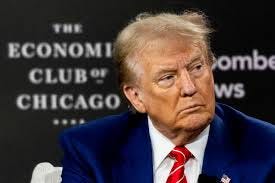Trump's Tariffs: A Plan for Inflation
Trump Wants to Impose a 20% or Higher Tariff on All Imported Goods
Despite economists’ prediction that Trump’s proposed tariffs on all imports would have a negative effect on the economy and drive inflation to levels not seen for 20 years, he persists with his tariff plan while not understanding the consequences of his own plan.
He first proposed a 20% tariff on all goods entering the United States. Then at an appearance at the Economic Club of Chicago last week, he said that he might increase the tariffs to 30% or 50% on all goods. Any of these proposals would have disastrous effects on the economy.
How does a tariff work and who pays it? U.S. Customs collects tariffs from the importers of foreign made goods. The importers then pass those tariffs along to their distributors and ultimately the consumer pays the tariff as the retail seller will add the cost of the tariff to the sale price of the goods. Harris has said this is like adding a 20% or higher sales tax to be paid by the consumer on all imported goods. She is correct.
So foreign goods that sold for $100 will now cost the U.S. consumer $120. If Trump increases the tariff to 30%, the goods will now sell for $130, and if he imposes a 50% tariff, the $100 goods will now cost the U.S. consumer $150.
Trump likes tariffs since under existing U.S. law the president is generally free to impose any tariff without congressional approval. He would have unbridled discretion to set tariffs on any goods and at any rate he chooses.
Can you imagine what would happen if your state government imposed a 20% or 30% sales tax on goods: consumers would descend on the legislature to abandon such confiscatory sales taxes.
But Trump would have a free hand to impose those tariffs (sales taxes) without citizen or Congressional approval.
But there are many other negative consequences to such 20% tariffs beyond the increased cost to the consumer.
First, other countries would retaliate by imposing their own tariffs on US exports which would reduce US exports and undermine US jobs.
Second, other countries could impose barriers to produce American products and particularly agricultural exports. After Trump imposed high tariffs on Chinese goods during his last term, China retaliated, quietly, by not buying U.S. soybeans and other agricultural products. The result was tremendous losses for US farmers. Trump then had to provide $30 billion of relief funds to farmers who suffered losses due to the China retaliatory purchase reductions.
Third, as the price of foreign goods increases from the Trump tariffs, US manufacturers of the same product will have an incentive to raise their prices to capture some of the price increases suffered by foreign exporters. The US manufacturers could raise prices 15% to still compete with the foreign manufacturers who see their prices rise by 20% tariffs.
So, Trump’s tariffs will increase costs to consumers, will invite retaliation by other countries imposing their own tariffs reducing US jobs, may result in foreign reduction in purchase of US goods and may result in US manufacturers raising their prices to US consumers to still underprice their foreign competitors subject to the Trump 20% tariffs.
We cannot let Trump gain the White House and impose these high tariffs having so many negative consequences while Congress would be powerless to act in light of the broad tariff authority granted to all presidents. Trump wants to return to the Smoot Hawley high tariffs of the past which many economists say contributed to causing the Great Depression.
Since Trump will not listen to reason on his tariff policy, the voters need to keep Trump far away from the White House.
To do so elect Kamala Harris and Tim Walz by high margins so that Trump will not have the opportunity to sink us in another Great Depression.




